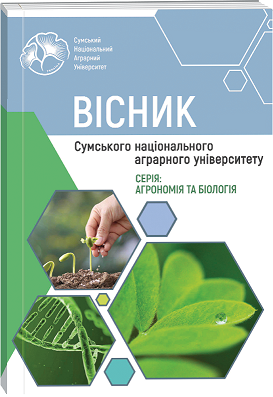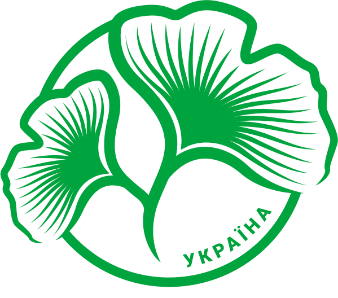THE VITALITY STRUCTURE OF TRIFOLIUM MEDIUM L. AND TRIFOLIUM MONTANUM L. POPULATIONS IN THE CONDITIONS OF MEADOWSTEPPE PHYTOCENOSES OF THE NATURE RESERVE “MYKHAILIVSKA TSILYNA”
Abstract
Steppe ecosystems in Ukraine are currently fragmented, largely transformed by anthropogenic activities and characterized by violations of the use regime in the territories of nature reserves, which makes the protection and conservation of steppe biodiversity, in particular, plant species that form a unique steppe phytocoenosis, an important area of research. Legumes play an important role in meadow-steppe phytocenoses, ensuring their stability, productivity and biodiversity. Population studies make it possible to assess the status and structure of populations of typical steppe species and, based on the results, to develop an action plan for their protection and reproduction. The article presents the results of the vitality analysis of six populations of Trifolium medium L. and three populations of Trifolium montanum L. growing in the conditions of meadow-steppe phytocenoses of the Nature Reserve “Mykhailivska Tsilyna”. The vitality analysis was carried out according to the generally accepted method by Yu.A. Zlobin. During the vitality analysis, it was found that, according to the vitality type, among the six populations of T. medium, four belonged to depressed (Q index values ranged from 0.0435 to 0.1250) and two populations were balanced (Q index values ranged from 0.2500 to 0.3250). None of the six populations of T. medium belonged to the prosperous ones. Among the three populations of T. montanum, two were depressed by vital rate (Q index values ranged from 0.0625 to 0.0938), and one population was balanced (Q index value was 0.3126). No populations of this species of prosperous type were found. The dependence between the mode of territory use and the quality index of T. medium and T. montanum populations was established. It was noted that populations under the haying regime had a higher quality index compared to populations growing in areas without haying, where populations had a significant proportion of individuals of the lower vitality class (c) and a lower quality index. The absence of populations of the thriving type indicates a deviation from the optimal growth conditions of the studied species on the territory of the Nature Reserve “Mykhailivska Tsilyna”. As part of the effective management of protected steppe areas, haymaking can contribute to the conservation of certain plant species, including legumes. At the same time, this process should be balanced, scientifically grounded and implemented, taking into account the specifics of a particular territory and its species diversity.
References
2. Bilyk, H.I. & Tkachenko, V.S. (1973). Zminy roslynnoho pokryvu stepu Mykhailivska tsilyna na Sumshchyni zalezhno vid rezhymu zapovidnosti [Changes in the vegetation cover of the Mykhailivska tsilyna steppe in Sumy Region depending on the regime of the nature reserve]. Ukr. botan. zhurnal, 30(1), 89–95 (in Ukrainian).
3. Bondarieva L. M. & Kyrylchuk K.S. (2011). Porivnialnyi analiz vitalitetnoi struktury zlakiv ta bobovykh na zaplavnykh lukakh Pivnichnoho Skhodu Ukrainy v umovakh paskvalnykh ta fenisytsialnykh navantazhen [Comparative analysis of the vitality structure of cereals and legumes in floodplain meadows of North-East Ukraine under conditions of Pasqual and Phoenician loads]. Visnyk SNAU. Seriia: Ahronomiia i biolohiia. 3 (29), 68–74 (in Ukrainian).
4. Bondarieva, L. M. & Kyrylchuk, K. S. (2023). Struktura populiatsii luchnykh roslyn na zaplavnykh lukakh Lisostepovoi zony za umov vypasannia ta sinokosinnia [The structure of meadow plant populations in floodplain meadows of the Forest-Steppe zone under conditions of grazing and haying]. Visnyk Sumskoho natsionalnoho ahrarnoho universytetu. Seriia: Ahronomiia i biolohiia. 51(1), 3–13 (in Ukrainian).
5. Burda, R.I. (1991). Antropohenna transformatsiia flory [Anthropogenic transformation of flora]. Nauk. Dumka, Kyiv, 168 (in Ukrainian).
6. Chytrá, H., Borovyk, D., Krejčová, M., Kadaš, D., Kizek, K., Večerík, Z., & Chytrý, K. (2023). Méně kosení, méně diverzity: vliv frekvence kosení na vegetaci suchých trávníků na jižní Moravě: Less mowing, less diversity: the effect of mowing frequency on vegetation of dry grasslands in southern Moravia. Příroda, 87–104.
7. Didukh, Ya.P., Borsukevych, L.M., Davydova, A.O., Dziuba, T.P., Dubyna, D.V., Yemelianova, S.M., Kolomiichuk, V.P., Kuzemko, A.A., Kucher, O.O., Moisiienko, I.I., Pashkevych, N.A., Fitsailo, T.V., Khodosovtsev, O.Ie., Tsarenko, P.M., Chusova, O.O., Shapoval, V.V. & Shyriaieva, D.V. (2020). Biotopy stepovoi zony Ukrainy [Biotope of the steppe zone] (Red. akademik NAN Ukrainy Ya.P. Didukh). Kyiv. Chernivtsi, DrukART, 392 (in Ukrainian).
8. Dluhošová, J., Ištvánek, J., Nedělník, J., & Řepková, J. (2018). Red Clover (Trifolium pratense) and Zigzag Clover (T. medium) – A Picture of Genomic Similarities and Differences. Frontiers in plant science, 9, 724. doi: 10.3389/fpls.2018.00724
9. Fedoronchuk, M. M. (2019). Konspekt rodyny Fabaceae u flori Ukrainy [Synopsis of the Fabaceae family in the flora of Ukraine]. IV. Pidrodyna Faboideae (tryby: Cicereae, Trifolieae, Lupulineae, Crotularieae, Genisteae). Ukrainskyi botanichnyi zhurnal, 76 (4), 281–300. (in Ukrainian).
10. Fitoriznomanittia zapovidnykiv i natsionalnykh pryrodnykh parkiv Ukrainy [Phytodiversity of reserves and national natural parks of Ukraine] (2012). Ch.1. Biosferni zapovidnyky. Pryrodni zapovidnyky. Kolektyv avtoriv pid red. V.A. Onyshchenka, T.L. Andriienko. Kyiv, Fitosotsiotsentr.
11. Harásek, M., Klinkovská, K. & Chytrý, M. (2023) Vegetation change in acidic dry grasslands in Moravia (Czech Republic) over three decades: Slow decrease in habitat quality after grazing cessation. Applied Vegetation Science, 26–39. doi: 10.1111/avsc.12726
12. Hrytsenko, V.V. (2004). Problemy okhorony luchno-stepovykh dilianok na Kyivshchyni [Problems of protecting meadow-steppe areas in the Kyiv region]. Materialy Mizhnarodnoi nauk. konf. Bioriznomanitnist flory: problemy zberezhennia i ratsionalnoho vykorystannia. Lviv, 99–100 (in Ukrainian).
13. Klinkovská, K., Sperandii, M. G., Trávníček, B. & Chytry, M. (2023). Significant decline in habitat specialists in semidry grasslands over four decades. Biodiversity and Conservation. 33, 1–18. doi: 10.1007/s10531-023-02740-6.
14. Klymenko, H., & Sherstiuk, M. (2019). Rare Plants of the Mykhailivs’ka Tsilyna Nature Reserve. Lesya Ukrainka Eastern European National University Scientific Bulletin. Series: Biological Sciences, 4(388). doi: 10.29038/2617-4723-2019-388-4-47-56.
15. Kolomiichuk, V.P., Ostapko, V.M. & Yarovyi, S.S. (2012). Pryrodnyi zapovidnyk Ukrainskyi stepovyi [Ukrainian Steppe Nature Reserve]. Fitoriznomanittia zapovidnykiv i natsionalnykh pryrodnykh parkiv Ukrainy. Ch. 1. Biosferni zapovidnyky. Pryrodni zapovidnyky. Fitosotsiotsentr, Kyiv, 336–378 (in Ukrainian).
16. Kovalenko, I. M. (2006). Struktura populiatsii dominantiv traviano-chaharnykovoho yarusu v lisovykh fitotsenozakh Desniansko-Starohutskoho natsionalnoho pryrodnoho parku. Vitalitetna. [Structure of populations of dominants of the herbaceous-shrub layer in forest phytocenoses of the Desnyansko-Starohutskyi National Nature Park. Vitalitet]. Ukr. botan. zhurnal, 63(3), 376 – 383 (in Ukrainian).
17. Kovalenko, I., Skliar, Iu., Klymenko, H., & Kovalenko, N. (2019). Vitality Structure of the Populations of Vegetative Motile Plants of Forest Ecosystems of the North-East of Ukraine. The Open Agriculture Journal, 13, 125–132. doi: 10.2174/1874331501913010125
18. Kyrylchuk, K. S. (2014). Populiatsiina struktura Medicago falcata L. na zaplavnykh lukakh Lisostepovoi zony v umovakh pasovyshchnykh ta sinokisnykh navantazhen [Population structure of Medicago falcata L. in floodplain meadows of the Forest-Steppe zone under conditions of pasture and haying loads]. Visnyk Kharkivskoho natsionalnoho universytetu imeni V. N. Karazina. Seriia: Biolohiia, 1100(20), 305–314 (in Ukrainian).
19. Kyrylchuk, K.S. (2017). Vitalitetna struktura populiatsii Trifolium pratense L. ta Trifolium repens L. na zaplavnykh lukakh v umovakh hospodarskoho korystuvannia [Vitality structure of Trifolium pratense L. and Trifolium repens L. populations in floodplain meadows under agricultural use]. Visnyk SNAU. Seriia Ahronomiia i Biolohiia. 2 (33), 12–16. (in Ukrainian).
20. Kyrylchuk, K., Skliar, V., Tykhonova, O. & Kobzhev, O. (2021). Vitality dynamics of populations of some legume species on floodplain meadows of the Psel river basin under grazing and haymaking (Ukraine). Horticulture. Scientific Papers. Series B. LXV(1), 406–414.
21. Larionov, M. S. (2022). Roslynnyi pokryv pryrodnoho zapovidnyka «Mykhailivska tsilyna»: istoriia doslidzhen ta suchasnyi stan [Vegetation cover of the Nature Reserve Mykhailivska Tsilyna: history of research and current state]. Visnyk Cherkaskoho universytetu. Seriia «Biolohichni nauky», 2, 53–65 (in Ukrainian).
22. Lavrenko, Ye.M. & Zoz, I.H. (1928). Roslynnist tsilyny Mykhailivskoho kinnoho zavodu (kol. Kapnista) Sumskoi okruhy [Roslinnistst tsiliny Mikhailivsky film factory (kol. Kapnist) Sumy district]. Okhorona pamiatok pryrody na Ukraini. Kharkiv, 2, 3–16 (in Ukrainian).
23. Lukjanová, E., Hanulíková, A., & Řepková, J. (2023). Investigating the Origin and Evolution of Polyploid Trifolium medium L. Karyotype by Comparative Cytogenomic Methods. Plants, 12(2), 235. doi: 10.3390/plants12020235
24. Melnyk V.I. (2001). Luchni stepy Lisostepu Ukrainy. Botaniko-heohrafchnyi narys [Meadow steppes of the Forest-Steppe of Ukraine. Botanical and geographical sketch]. Visti biosfernoho zapovidnyka Askaniia Nova, 3, 7–14 (in Ukrainian).
25. Parnikoza, I., Vasyliuk, O. & Inozemtseva, D. (2009). Stepy Kyivskoi oblasti. Suchasnyi stan ta problemy zberezhennia [Steppes of Kyiv region. Current status and conservation problems]. Seriia: Zberezhemo ukrainski stepy, 160 (in Ukrainian).
26. Pryrodno-zapovidnyi fond Sumskoi oblasti: Atlas-dovidnyk [Nature reserve fund of the Sumy region: Atlas-guide] (2019) / [uklad.: R.V. Boichenko, V.V. Vertel, O.Iu. Karliukova ta in.]. TOV «Ukrainska Kartohrafichna Hrupa», K., 96.
27. Rodinka, O.S. (2014). Florystychni zminy u zapovidnyku «Mykhailivska tsilyna» ta yikh prychyny [Floristic changes in the reserve «Mykhailivska tsilyna» and their causes]. Pryrodnychi nauky, 11, 52–57 (in Ukrainian).
28. Singh, B. & Sharma, R.A. (2020). Trifolium Species. In Secondary Metabolites of Medicinal Plants, doi: 10.1002/9783527825578.c02-92
29. Skliar, V., Kovalenko, I., Skliar, Iu. & Sherstiuk, M. (2019). Vitality structure and its dynamics in the process of natural reforestation of Quercus robur L. AgroLife Scientific Journal, 8 (1), 233–241. Access mode: https://agrolifejournal.usamv. ro/index.php/agrolife/article/view/441
30. Skliar, V., Kyrylchuk, K., Tykhonova, O., Bondarieva, L., Zhatova, H., Klymenko, A., Mykola Bashtovyi, M., & Zubtsova, I. (2020). Ontogenetic structure of populations of forest-forming species of the Left-Bank Polissya of Ukraine. Baltic Forestry, 26(1), 441 https://doi.org/10.46490/BF441
31. Tkachenko, V. S., Henov, A.P. & Lysenko, H.M. (1991). Struktura roslynnosti zapovidnoho stepu «Mykhailivska tsilyna» za danymy krupnomasshtabnoho kartuvannia v 1991 rotsi [Vegetation structure of the protected steppe “Mykhailivska tsilyna “ according to the data of large-scale mapping in 1991]. Ukr. botan. zhurn., 50(4), 5–15 (in Ukrainian).
32. Tkachenko, V.S. & Lysenko, H.M. (2005). Synfitoindykatsiia postpirohennykh zmin ekotopichnykh kharakterystyk luchnoho stepu «Mykhailivska tsilyna» na Sumshchyni (Ukraina) [Synphytoindication of post-pyrogenic changes in the ecotopic characteristics of the meadow steppe «Mykhailivska tsilyna » in Sumy Oblast (Ukraine)]. Ukr. botan. zhurn., 62(4), 468–482 (in Ukrainian).
33. Tykhonova, O., Skliar, V., Sherstiuk, M., Kyrylchuk, K., Butenko, A., & Bashtovyi, M. (2021). Analysis of Setaria glauca (L.) P. Beauv. Population’s Vital Parametres in grain Agrophytocenoses. Environmental Research, Engineering and Management 77(1), 33‒46. doi: 10.5755/j01.erem.77.1.25489
34. Yaroshenko, N.P. (2023). Otsinka ontohenetychnykh ta zhyttievykh struktur populiatsii Lathyrus vernus (L.) Bernh v Hettinhenskomu lisi Nnyzhnia Saksoniia, Nimechchyna) [Assessment of ontogenetic and life history structures of Lathyrus vernus (L.) Bernh populations in the Göttingen Forest (Lower Saxony, Germany)]. Visnyk Sumskoho natsionalnoho ahrarnoho universytetu. Seriia: Ahronomiia i biolohiia. 54, 4, 68–73 (in Ukrainian). doi: 10.32782/agrobio.2023.4.10.
35. Zlobin, Yu. A., Skliar, V. G. & Klymenko, G. O. (2022) Biologiia ta ekologiia fitopopuliatsii [Biology and ecology of phytopopulations]. Universytetska knyga, Sumy, 512 (in Ukrainian).
36. Zlobin, Yu., Kovalenko, I., Klymenko, H., Kyrylchuk, K., Bondarieva, L., Tykhonova, O. & Zubtsova, I. (2021). Vitality Analysis Algorithm in the Study of Plant Individuals and Populations. The Open Agriculture Journal, 15, 119–129. doi: 10.2174/1874331502115010119
37. Zlobin, Yu.A. (2018). Alhorytm otsinky vitalitetu osobyn roslyn i vitalitetnoi struktury fitopopuliatsii. [An algorithm for assessing the vitality of plant individuals and the vitality structure of phytopopulations]. Chornomorskyi botanichnyi zhurnal, 14(3), 213–226 (in Ukranian). doi: 10.14255/2308-9628/18.143/2
38. Zubtsova, I. V., Skliar, V.H., Melnychuk, S.D. & Bondarieva, L.M. (2019). Vitalitetna struktura tsenopopuliatsii Melilotus officinalis (L.) Pall. v umovakh zaplavnykh luk Krolevetsko-Hlukhivskoho heobotanichnoho raionu [Vitality structure of cenopopulations of Melilotus officinalis (L.) Pall. in floodplain meadows of the Krolevets-Hlukhiv geobotanical region]. Visnyk SNAU, seriia «Ahronomiia i Biolohiia», 1–2 (35–36), 10–15 (in Ukrainian).

 ISSN
ISSN  ISSN
ISSN 



